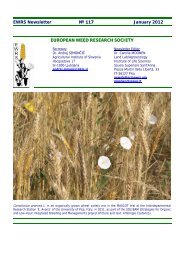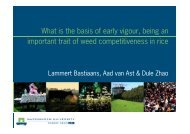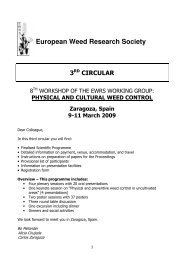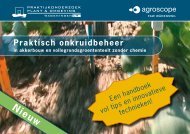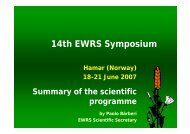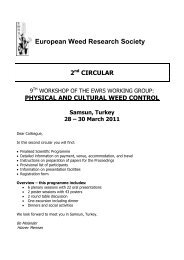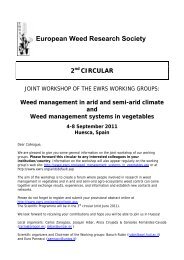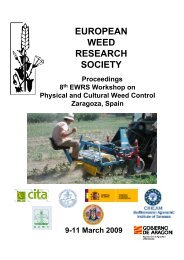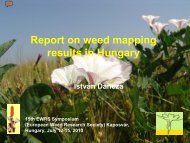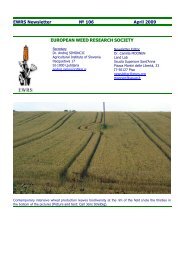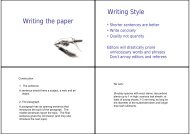Physical and Cultural Weed Control Working Group of - European ...
Physical and Cultural Weed Control Working Group of - European ...
Physical and Cultural Weed Control Working Group of - European ...
You also want an ePaper? Increase the reach of your titles
YUMPU automatically turns print PDFs into web optimized ePapers that Google loves.
9 th EWRS Workshop on <strong>Physical</strong> <strong>and</strong> <strong>Cultural</strong> <strong>Weed</strong> <strong>Control</strong> 53<br />
Samsun, Turkey, 28 – 30 March 2011<br />
Lolium perenne (L.) (Perennial Ryegrass), Festuca platensis Huds., Poa pratensis (L.)<br />
(Smooth Meadow Grass), Phleum platens (L.) (Timothy Grass) – individually or in mixture with<br />
Trifolium repens (L.) (White Clover) or Trifolium pratense (L.) (Red Clover).<br />
The following grass mixtures are recommended for inter-rows: 40 – 50 kg/ha L. perenne or 30<br />
– 40 kg/ha L. perenne + 2 kg/ha T. repens; 20 – 30 kg/ha F. platens + 2 kg/ha T. repens; 20 – 25<br />
kg/ha F. platens + 2 kg/ha T. repens (Stamatov, 1982). The seeds <strong>of</strong> the grass mixtures are sown in<br />
spring (April) on the year <strong>of</strong> planting <strong>of</strong> the new orchard or in the following years. If there is a<br />
system for irrigation, sowing <strong>of</strong> the grass can be performed in the year <strong>of</strong> planting <strong>of</strong> the young<br />
trees. If no irrigation is provided, then it is advisable to sow the grass in the second or the third year<br />
after planting <strong>of</strong> the trees when they have developed a deeper root system in order to limit the<br />
competition between the grasses <strong>and</strong> the trees. The grasses are mowed periodically to a height <strong>of</strong> 10<br />
– 12 cm. The mowed down mass is left at the site as mulch, thus also delivering additional organic<br />
substances to the soil.<br />
The main advantages <strong>of</strong> the grass-mulch system are the enhancement <strong>of</strong> the soil structure <strong>and</strong><br />
the regime <strong>of</strong> the water, air <strong>and</strong> nutrients. It allows for passage <strong>of</strong> agricultural machines throughout<br />
the year without formation <strong>of</strong> grooves. Grass mixtures suppress the development <strong>of</strong> weeds,<br />
including tenacious perennial species forming rhizomes <strong>and</strong> root <strong>of</strong>fshoots: S. halepense, C.<br />
dactylon, C. arvensis, C. arvense (Stamatov et al., 1982; Mitov et al., 1981)<br />
Research on the influence <strong>of</strong> the grass-mulching system on the development <strong>of</strong> apple trees <strong>and</strong><br />
the quantity <strong>and</strong> composition <strong>of</strong> the soil micr<strong>of</strong>lora shows that the trees develop well under irrigated<br />
conditions (Taseva <strong>and</strong> Ilieva, 1992; Taseva, 1995).<br />
Grass systems are suitable for maintenance <strong>of</strong> the soil surface in plantings in mountain <strong>and</strong><br />
hilly regions in the country, preventing erosion (Domozetov <strong>and</strong> Doychev, 1999; Petrov et al.,<br />
1994).<br />
Under analogous conditions it is recommended that cover crops are grown in the inter-rows to<br />
provide green manure. It has been established that winter fodder peas <strong>and</strong> mixtures <strong>of</strong> peas <strong>and</strong> rye<br />
are suitable for green fertilization <strong>of</strong> young plum plantings <strong>and</strong> contribute to the increase <strong>of</strong> the<br />
organic content in the soil (Petrov et al., 1994; Vitanova, 1995). Green fertilization with repco has a<br />
positive effect on the vegetative growth <strong>and</strong> yield <strong>of</strong> apricot trees (Nikolova, 1995).<br />
The results <strong>of</strong> the research on the impact <strong>of</strong> different systems for maintenance <strong>of</strong> the soil<br />
surface with almond tree plantings show different influence on tree growth, yield <strong>and</strong> fruit quality<br />
(Rankova <strong>and</strong> Djeneva, 2010; Rankova <strong>and</strong> Djeneve, in print). Winter peas <strong>and</strong> vetch can be<br />
recommended as crops, suitable for green manure with a positive effect on fruit yield. Winter broad<br />
beans are not suitable for green manure as this cover crop has a negative influence on fruit tree<br />
growth <strong>and</strong> yield. The application <strong>of</strong> a combination <strong>of</strong> herbicides selective for almond trees in the<br />
rows (4 l/ha pendimetalin Stomp 33 EK <strong>and</strong> 6 l/ha diuron + glyphosate, Trevisimo – 10 l/ha) <strong>and</strong><br />
planting <strong>of</strong> crops for green fertilization in the inter-rows – winter peas <strong>and</strong> vetch – comprise a<br />
suitable system for maintenance <strong>of</strong> the soil surface which provides effective weed control <strong>and</strong> has a<br />
positive effect on the growth <strong>and</strong> yield <strong>of</strong> the fruit trees.<br />
Conclusion<br />
The application <strong>of</strong> a complex <strong>of</strong> agrotechnical approaches for maintenance <strong>of</strong> the soil surface in<br />
fruit tree plantings based on the choice <strong>of</strong> a system suitable for the local soil <strong>and</strong> climatic conditions<br />
<strong>and</strong> for the biological characteristics <strong>of</strong> the cultivar – rootstock combinations is an important<br />
element in Integrated Fruit Production. The creative integration <strong>of</strong> different approaches ensures<br />
maintenance <strong>of</strong> the plantings in good agrotechnical <strong>and</strong> ecological condition.



